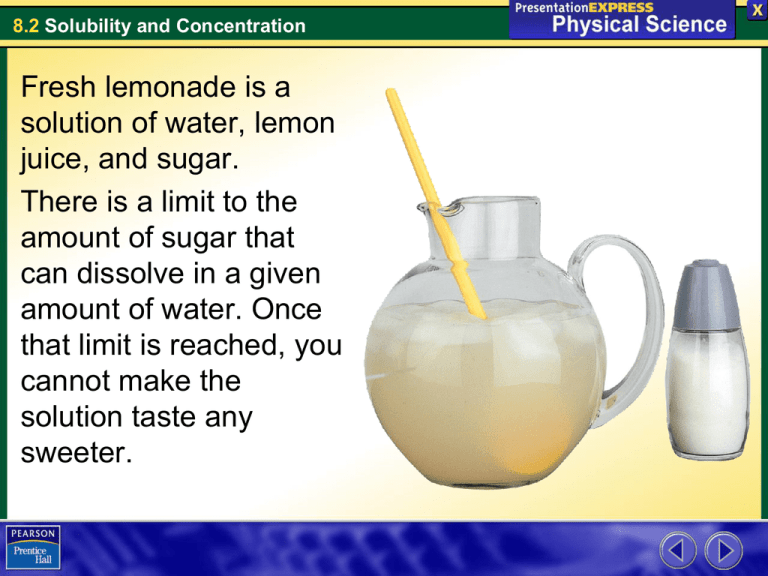Fresh lemonade is a solution of water, lemon juice, and sugar.
advertisement

8.2 Solubility and Concentration Fresh lemonade is a solution of water, lemon juice, and sugar. There is a limit to the amount of sugar that can dissolve in a given amount of water. Once that limit is reached, you cannot make the solution taste any sweeter. 8.2 Solubility and Concentration Solubility Solutions are described as saturated, unsaturated, or supersaturated, depending on the amount of solute in solution. The maximum amount of a solute that dissolves in a given amount of solvent at a constant temperature is called ________________. Solubilities are usually expressed in grams of solute per ____ grams of solvent at a specified temperature. 8.2 Solubility and Concentration Solubility At a given temperature, different substances have different solubilities in __________. 8.2 Solubility and Concentration Solubility Saturated Solutions A saturated solution is one that contains as much solute as the solvent can hold at a given _________. At 20°C, 203.9 grams of table sugar will dissolve in 100 grams of water. If you add more sugar, it will not dissolve. 8.2 Solubility and Concentration Solubility Unsaturated Solutions A solution that has____than the maximum amount of solute that can be dissolved is called an unsaturated solution. As long as the amount of solute is less than the solubility at that temperature, the solution is unsaturated. 8.2 Solubility and Concentration Solubility Supersaturated Solutions A supersaturated solution is one that contains ____ solute than it can normally hold at a given temperature. A solvent can sometimes dissolve more solute than you might expect, based on its solubility. If you _______ a solution, more solute may dissolve. Carefully cool the solution without jarring it and the extra solute in solution remains. 8.2 Solubility and Concentration Solubility Supersaturated solutions are very unstable. When a single crystal of sodium acetate is added to a supersaturated solution of sodium acetate in water, the excess solute rapidly crystallizes. 8.2 Solubility and Concentration Solubility Three factors that affect the solubility of a solute are the polarity of the solvent, temperature, and pressure. Polar and Nonpolar Solvents Oil does not dissolve in water because oil molecules are _________and water molecules are _______. Solutions are more likely to form when the solute and solvent are either ______ polar or ______ nonpolar. A soap molecule has a polar end, which attracts water molecules, and a nonpolar end, which attracts oil. 8.2 Solubility and Concentration Solubility Generally, a solute is more likely to dissolve in a “like” solvent than an “unlike” solvent. 8.2 Solubility and Concentration Solubility Soaps and detergents are used to remove grease and oil stains. 8.2 Solubility and Concentration Solubility Temperature In general, the solubility of _______ increases as the solvent temperature increases. In general, gases become ______ soluble as the temperature of the solvent increases. 8.2 Solubility and Concentration Solubility Pressure Increasing the pressure on a gas _____________ its solubility in a liquid. The pressure of CO2 in a sealed 12-ounce can of soda at room temperature can be ___________times atmospheric pressure. 8.2 Solubility and Concentration Concentration of Solutions The _______________ of a solution is the amount of solute dissolved in a specified amount of solution. Concentration can be expressed as percent by volume, percent by mass, and molarity. 8.2 Solubility and Concentration Concentration of Solutions Percent by Volume Most bottled or canned juices are made by adding water to natural fruit juices. These solutions are less concentrated than natural fruit juices. Percent by volume is a way to measure the concentration of one _________ dissolved in another. 8.2 Solubility and Concentration Concentration of Solutions Percent by Mass Concentration expressed as a percent by mass is more useful when the solute is a _______. Percent by mass is the percent of a solution’s total mass that is accounted for by solute. Ex: sugar in water 8.2 Solubility and Concentration Concentration of Solutions Molarity To compare the number of solute particles in solutions, chemists often use moles to measure concentration. Molarity is the number of _____ of a solute dissolved per liter of solution. A _______ is the amount of a substance that contains approximately 6.02 X 1023 particles.



